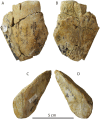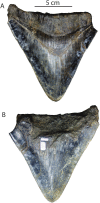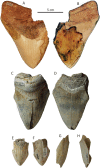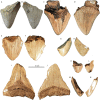The Early Pliocene extinction of the mega-toothed shark Otodus megalodon: a view from the eastern North Pacific - PubMed (original) (raw)
The Early Pliocene extinction of the mega-toothed shark Otodus megalodon: a view from the eastern North Pacific
Robert W Boessenecker et al. PeerJ. 2019.
Abstract
The extinct giant shark Otodus megalodon is the last member of the predatory megatoothed lineage and is reported from Neogene sediments from nearly all continents. The timing of the extinction of Otodus megalodon is thought to be Pliocene, although reports of Pleistocene teeth fuel speculation that Otodus megalodon may still be extant. The longevity of the Otodus lineage (Paleocene to Pliocene) and its conspicuous absence in the modern fauna begs the question: when and why did this giant shark become extinct? Addressing this question requires a densely sampled marine vertebrate fossil record in concert with a robust geochronologic framework. Many historically important basins with stacked _Otodus_-bearing Neogene marine vertebrate fossil assemblages lack well-sampled and well-dated lower and upper Pliocene strata (e.g., Atlantic Coastal Plain). The fossil record of California, USA, and Baja California, Mexico, provides such an ideal sequence of assemblages preserved within well-dated lithostratigraphic sequences. This study reviews all records of Otodus megalodon from post-Messinian marine strata from western North America and evaluates their reliability. All post-Zanclean Otodus megalodon occurrences from the eastern North Pacific exhibit clear evidence of reworking or lack reliable provenance; the youngest reliable records of Otodus megalodon are early Pliocene, suggesting an extinction at the early-late Pliocene boundary (∼3.6 Ma), corresponding with youngest occurrences of Otodus megalodon in Japan, the North Atlantic, and Mediterranean. This study also reevaluates a published dataset, thoroughly vetting each occurrence and justifying the geochronologic age of each, as well as excluding several dubious records. Reanalysis of the dataset using optimal linear estimation resulted in a median extinction date of 3.51 Ma, somewhat older than a previously proposed Pliocene-Pleistocene extinction date (2.6 Ma). Post-middle Miocene oceanographic changes and cooling sea surface temperature may have resulted in range fragmentation, while alongside competition with the newly evolved great white shark (Carcharodon carcharias) during the Pliocene may have led to the demise of the megatoothed shark. Alternatively, these findings may also suggest a globally asynchronous extinction of Otodus megalodon.
Keywords: Baja California; California; Extinction; Lamniformes; Miocene; North Pacific; Otodontidae; Otodus; Otodus megalodon; Pliocene.
Conflict of interest statement
The authors declare that they have no competing interests.
Figures
Figure 1. Map of California and Baja California showing genuine late Miocene and Early Pliocene records of Otodus megalodon, and dubious Late Pliocene and Pleistocene records.
Figure 2. Otodus megalodon teeth from the Capistrano Formation.
SDNHM 53167 in lingual (A) and labial (B) view; LACM 129982 in lingual (C) and labial (D) view; LACM 59837 in lingual (E) and labial (F) view; LACM 115989 in lingual (G) and labial (H) view; LACM 59836 in lingual (I) and labial (J) view.
Figure 3. Otodus megalodon teeth from the Fernando Formation.
LACM 148312 in lingual (A) and labial (B) view; LACM 148311 in lingual (C) and labial (D) view.
Figure 4. Otodus megalodon tooth from the Niguel Formation.
LACM 59065 in lingual (A) and labial (B) view.
Figure 5. Otodus megalodon tooth from the Purisima Formation.
UCMP 219502 in lingual (A) and labial (B) view.
Figure 6. Otodus megalodon teeth from the San Diego Formation.
SDNHM 29742 in lingual (A) and labial (B) view; LACM 156334 in lingual (C) and labial (D) view; LACM 10152 in lingual (E) and labial (F) view; LACM 103448 in lingual (G) and labial (H) view.
Figure 7. Otodus megalodon teeth from the San Mateo Formation.
LACM 131149 in lingual (A) and labial (B) view; SDNHM 24448 in lingual (C) and labial (D) view; SDNHM 23959 in lingual (E) and labial (F) view; SDNHM 77343 in lingual (G) and labial (H) view; SDNHM 23959 in lingual (I) and labial (J) view; SDNHM 23959 in lingual (K) and labial (L) view; SDNHM 23959 in lingual (M) and labial (N) view.
Figure 8. Otodus megalodon teeth from the Tirabuzón Formation.
LACM 29067 in lingual (A) and labial (B) view; LACM 29064 in lingual (C) and labial (D) view; LACM 29077 in lingual (E) and labial (F) view; LACM 29076 in lingual (G) and labial (H) view; LACM 29065 in lingual (I) and labial (J) view; LACM 29074 in lingual (K) and labial (L) view; LACM 29069 in lingual (M) and labial (N) view; LACM 29073 in lingual (O) and labial (P) view; LACM 29075 in lingual (Q) and labial (R) view; LACM 29072 in lingual (S) and labial (T) view.
Figure 9. Inferred dates of extinction for Otodus megalodon using the Optimal Linear Estimation (OLE) model.
Data binned by 10,000 year increments. The histogram (blue) represents the % frequency of a given date that was estimated for the extinction out of 10,000 simulations. The curve (orange) represents increasing cumulative probability that Otodus megalodon was extinct at the given date.
Figure 10. Otodus megalodon teeth of purported Pleistocene age.
LACM 159028 in lingual (A) and labial (B) view, supposedly from Palos Verdes Sand; LACM 10141 in lingual (C) and labial (D) view, supposedly from unnamed strata at Newport Bay Mesa.
Figure 11. Geochronologic age range of _Otodus megalodon_-bearing strata and occurrences in the eastern North Pacific.
Age control of latest Miocene and Pliocene _Otodus megalodon_-bearing stratigraphic units represented by thick vertical gray bars. Stratigraphic range of autochthonous and parautochthonous Otodus megalodon occurrences (allochthonous records excluded) depicted as thin vertical black bars. Abbreviations: NALMA, North American Land Mammal Age.
Similar articles
- The Deep Past of the White Shark, Carcharodon carcharias, in the Mediterranean Sea: A Synthesis of Its Palaeobiology and Palaeoecology.
Collareta A, Casati S, Di Cencio A, Bianucci G. Collareta A, et al. Life (Basel). 2023 Oct 20;13(10):2085. doi: 10.3390/life13102085. Life (Basel). 2023. PMID: 37895466 Free PMC article. Review. - White shark comparison reveals a slender body for the extinct megatooth shark, Otodus megalodon (Lamniformes: Otodontidae).
Sternes PC, Jambura PL, Türtscher J, Kriwet J, Siversson M, Feichtinger I, Naylor GJP, Summers AP, Maisey JG, Tomita T, Moyer JK, Higham TE, da Silva JPCB, Bornatowski H, Long DJ, Perez VJ, Collareta A, Underwood C, Ward DJ, Vullo R, González-Barba G, Maisch HM, Griffiths ML, Becker MA, Wood JJ, Shimada K. Sternes PC, et al. Palaeontol Electronica. 2024 Jan 1;27(1):a7. doi: 10.26879/1345. eCollection 2024 Jan 1. Palaeontol Electronica. 2024. PMID: 39404696 Free PMC article. - Trophic position of Otodus megalodon and great white sharks through time revealed by zinc isotopes.
McCormack J, Griffiths ML, Kim SL, Shimada K, Karnes M, Maisch H, Pederzani S, Bourgon N, Jaouen K, Becker MA, Jöns N, Sisma-Ventura G, Straube N, Pollerspöck J, Hublin JJ, Eagle RA, Tütken T. McCormack J, et al. Nat Commun. 2022 May 31;13(1):2980. doi: 10.1038/s41467-022-30528-9. Nat Commun. 2022. PMID: 35641494 Free PMC article. - Use of nursery areas by the extinct megatooth shark Otodus megalodon (Chondrichthyes: Lamniformes).
Herraiz JL, Ribé J, Botella H, Martínez-Pérez C, Ferrón HG. Herraiz JL, et al. Biol Lett. 2020 Nov;16(11):20200746. doi: 10.1098/rsbl.2020.0746. Epub 2020 Nov 25. Biol Lett. 2020. PMID: 33232650 Free PMC article. - Historical biogeography of the Isthmus of Panama.
Leigh EG, O'Dea A, Vermeij GJ. Leigh EG, et al. Biol Rev Camb Philos Soc. 2014 Feb;89(1):148-72. doi: 10.1111/brv.12048. Epub 2013 Jul 19. Biol Rev Camb Philos Soc. 2014. PMID: 23869709 Review.
Cited by
- Endothermic physiology of extinct megatooth sharks.
Griffiths ML, Eagle RA, Kim SL, Flores RJ, Becker MA, Maisch HM 4th, Trayler RB, Chan RL, McCormack J, Akhtar AA, Tripati AK, Shimada K. Griffiths ML, et al. Proc Natl Acad Sci U S A. 2023 Jul 4;120(27):e2218153120. doi: 10.1073/pnas.2218153120. Epub 2023 Jun 26. Proc Natl Acad Sci U S A. 2023. PMID: 37364100 Free PMC article. - Biomechanical insights into the dentition of megatooth sharks (Lamniformes: Otodontidae).
Ballell A, Ferrón HG. Ballell A, et al. Sci Rep. 2021 Jan 13;11(1):1232. doi: 10.1038/s41598-020-80323-z. Sci Rep. 2021. PMID: 33441828 Free PMC article. - Dental pathologies in lamniform and carcharhiniform sharks with comments on the classification and homology of double tooth pathologies in vertebrates.
Miller HS, Avrahami HM, Zanno LE. Miller HS, et al. PeerJ. 2022 May 11;10:e12775. doi: 10.7717/peerj.12775. eCollection 2022. PeerJ. 2022. PMID: 35578672 Free PMC article. - The Deep Past of the White Shark, Carcharodon carcharias, in the Mediterranean Sea: A Synthesis of Its Palaeobiology and Palaeoecology.
Collareta A, Casati S, Di Cencio A, Bianucci G. Collareta A, et al. Life (Basel). 2023 Oct 20;13(10):2085. doi: 10.3390/life13102085. Life (Basel). 2023. PMID: 37895466 Free PMC article. Review. - An early Eocene fish assemblage associated with a barite deposit in the lower part of the Crescent Formation, Olympic Peninsula, Washington State, USA.
Goedert JL, Kiel S, Thomas EJ, Kriwet J. Goedert JL, et al. Palaontol Z. 2024;98(3):443-467. doi: 10.1007/s12542-024-00692-y. Epub 2024 Jul 9. Palaontol Z. 2024. PMID: 39359717 Free PMC article.
References
- Agassiz LJR. Recherches sur les poissons fossiles. Tome III (livr. 11) Neuchatel: Imprimérie de Petitpierre; 1838.
- Agassiz LJR. Recherches sur les poissons fossiles. Tome III (livr. 15–16) Neuchatel: Imprimerie de Petitpierre; 1843.
- Aguilera OA, Garcia L, Cozzuol MA. Giant-toothed white sharks and cetacean trophic interaction from the Pliocene Caribbean Paraguana Formation. Paläontologische Zeitschrift. 2004;82(2):204–208. doi: 10.1007/bf02988410. - DOI
- Antunes MT. Faunes ichthyologiques du Néogène supérieur d’Angola, leur age, remarques sur le Pliocéne marin en Afrique australe. Ciênces da Terra (UNL) 1978;4:59–90.
- Applegate SP. Phyletic studies. Part 1. Tiger sharks. Universidad Nacional Autonoma de Mexico, Instituto de Geologia, Revista. 1978;2:55–64.
Grants and funding
No specific grant funding was requested for this study. RW Boessenecker benefited from a University of Otago Doctoral Scholarship during early stages of this research, conducted in 2012–2014. The funders had no role in study design, data collection and analysis, decision to publish, or preparation of the manuscript.
LinkOut - more resources
Full Text Sources










